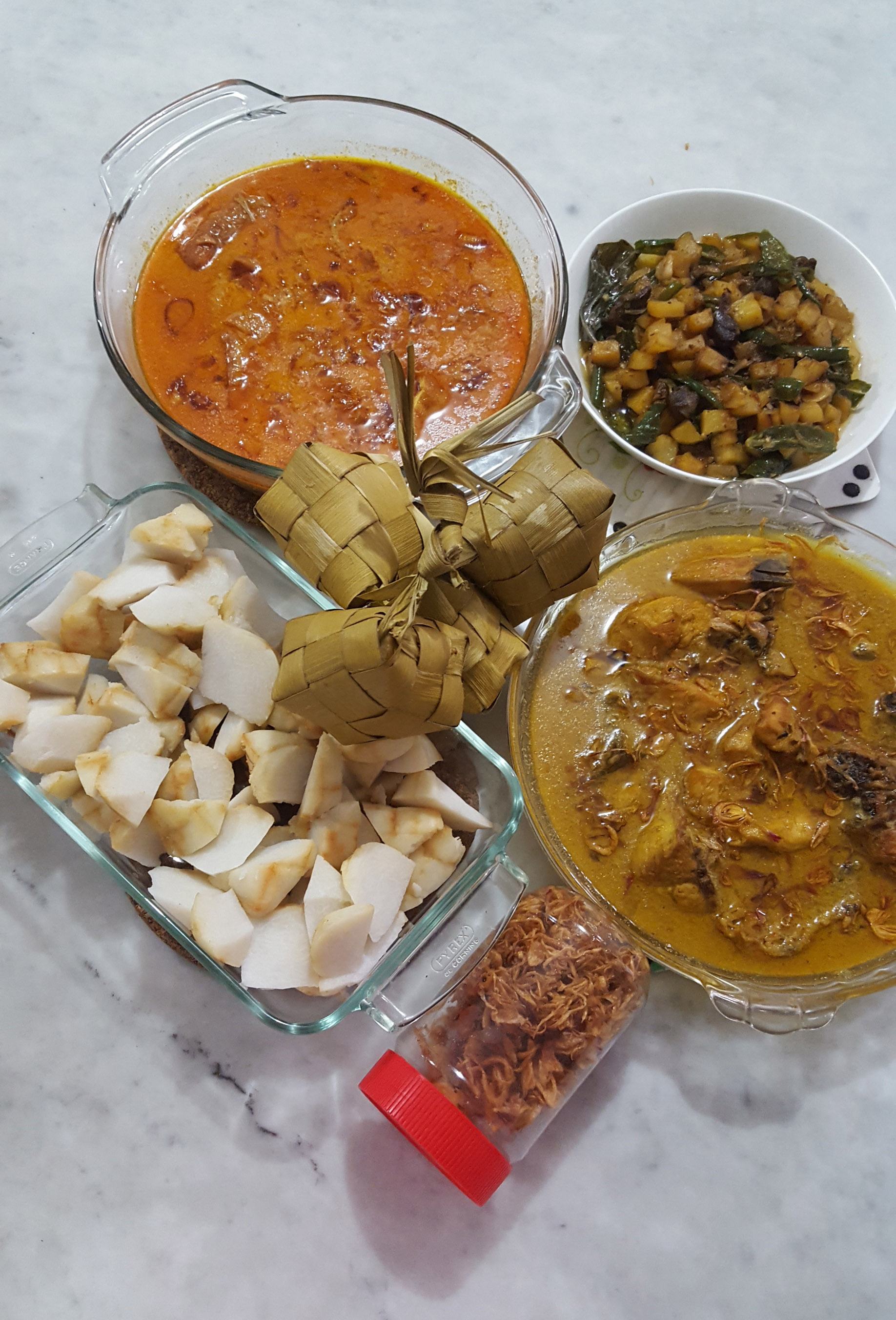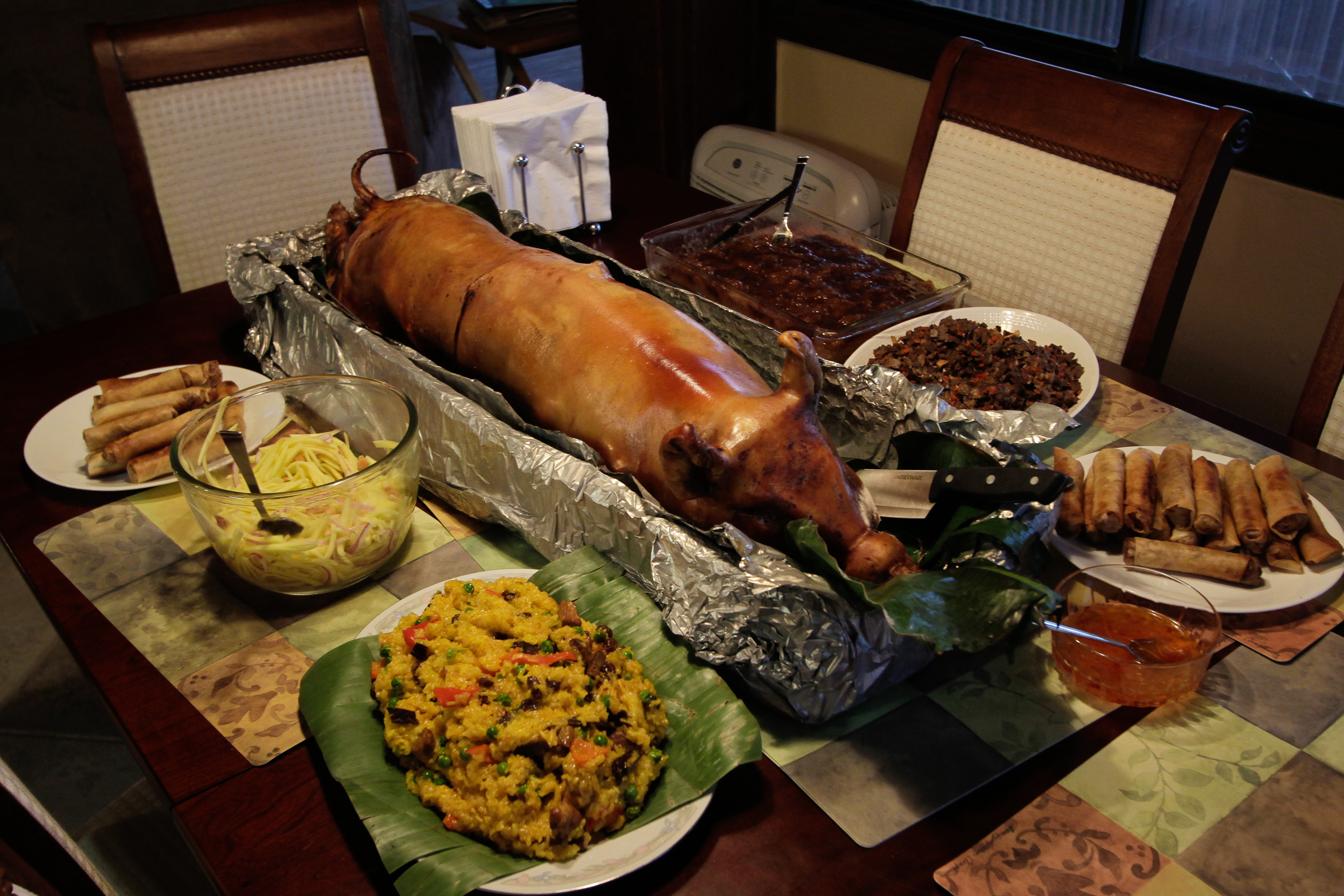|
Kuning
''Kuning'', also spelled ''koning'', ''kyuning'', or ''kiyuning'' and Anglicized as yellow rice or turmeric rice, is a Filipino rice dish cooked with turmeric, lemongrass, salt, bay leaves, and other spices to taste. It originates from the island of Mindanao and is a staple food among the Maranao people of Lanao del Sur. It is related to the Indonesian ''nasi kuning'' of neighboring Sulawesi, but it does not use coconut milk. The dish is characteristically yellow because of the use of turmeric (''kalawag'' in Maranao, and ''kunig'' or ''luyang dilaw'' in most other Philippine languages). See also * Bringhe * Java rice * Palapa * Sinigapuna ''Sinigapuna'' is a Filipino rice dish cooked with turmeric and other spices. It originates from Kalagan (or Caragan) people of the Caraga and Davao Regions of Mindanao. It is similar to the Maranao '' kuning'', and Indonesian ''nasi kuning' ... * Sinangag References {{Filipino food Philippine rice dishes ... [...More Info...] [...Related Items...] OR: [Wikipedia] [Google] [Baidu] |
Nasi Kuning
''Nasi kuning'' (literally, "yellow rice"; ), or sometimes called ''nasi kunyit'' (literally, "turmeric rice"; ), is an Indonesian fragrant rice dish cooked with coconut milk and turmeric, hence the name ''nasi kuning'' (yellow rice). ''Nasi kuning'' also can be found in neighbouring Malaysia, Brunei, Singapore and Cocos Island, Australia. Because of its perceived favourable fortune and auspicious meaning, ''nasi kuning'' is often served as a special dish for celebrations; e.g. community rituals, ceremonies, birthdays, weddings, anniversaries and also the independence day celebration. Nevertheless, it is also a favourite dish for breakfast in Indonesia. In the Philippines, a related dish exists in Mindanao, particularly among the Maranao people, where it is known as '' kuning''. Like the Indonesian version, it primarily uses turmeric, but also adds lemongrass and does not use coconut milk. A similar dish is also found in Sri Lankan cuisine where it is known as ''kaha buth'' ... [...More Info...] [...Related Items...] OR: [Wikipedia] [Google] [Baidu] |
Sinangag
''Sinangag'' (), also called garlic fried rice or garlic rice, is a Filipino fried rice dish cooked by stir-frying pre-cooked rice with garlic. The rice used is preferably stale, usually leftover cooked rice from the previous day, as it results in rice that is slightly fermented and firmer. It is garnished with toasted garlic, rock salt, black pepper and sometimes chopped scallions. The rice grains are ideally loose and not stuck together. It is rarely eaten on its own, but is usually paired with a "dry" meat dish such as tocino (bacon), ''longganisa'' (sausage), ''tapa'' (dried or cured meat), Spam, or ''daing'' (dried fish), as well as the addition of scrambled or fried eggs. Unlike other types of fried rice, it does not normally use ingredients other than garlic, in order not to overwhelm the flavour of the main dish. In the Visayas regions of the Philippines, ''sinangag'' was traditionally seasoned with '' asín tibuok''. ''Sinangag'' is a common part of a traditional Fili ... [...More Info...] [...Related Items...] OR: [Wikipedia] [Google] [Baidu] |
Indonesian Cuisine
Indonesian cuisine is a collection of various regional culinary traditions by various ethnic groups that formed in the archipelagic nation of Indonesia. There are a wide variety of recipes and cuisines in part because Indonesia is composed of approximately 6,000 populated List of islands of Indonesia, islands of the total 17,508 in the world's largest archipelago,"Indonesian Cuisine." . Accessed July 2011. Tradition and characteristics Indonesia has around 5,350 traditional recipes, with 30 of them ...[...More Info...] [...Related Items...] OR: [Wikipedia] [Google] [Baidu] |
Java Rice
Java rice, sometimes called yellow fried rice, is a Filipino fried rice dish characterized by its yellow-orange tint from the use of turmeric or annatto. Variants of the dish add bell peppers, pimiento, paprika, and/or tomato ketchup to season the fried rice. Despite its name, it does not originate from Java or Indonesia in general. Although its actual origin is uncertain, java rice is associated with Engracia Cruz-Reyes' Aristocrat restaurant (founded in 1936 in Manila), in part due to their popularization of serving their chicken barbecue ('' inihaw'') with this preparation of rice. See also * Kuning - a Filipino rice dish with turmeric related to ''nasi kuning'' * Sinigapuna - a Filipino rice dish with turmeric * Arroz a la valenciana - a Hispanic Filipino yellow sticky rice dish, similar to ''paella'' * Nasi goreng - a dark yellow-colored Indonesian fried rice dish which uses turmeric and other ingredients * Nasi kuning ''Nasi kuning'' (literally, "yellow rice"; ... [...More Info...] [...Related Items...] OR: [Wikipedia] [Google] [Baidu] |
Bringhe
Paelya () or paella (Spanish) is a Philippine rice dish adapted from the Valencian ''paella''. However, it differs significantly in its use of native glutinous rice (''malagkít''), giving it a soft and sticky texture, unlike the ''al dente'' texture favoured in Spanish ''paella''. It is also characteristically topped with sliced eggs. Filipino ''paelya'' does not use saffron, but is instead coloured with ''atsuete'' (anatto), ''luyang diláw'' (turmeric), or ''kasubhâ'' (safflower). ''Paelya'' is also a umbrella term, general term for similar dishes in the Philippines, regardless of the ingredients used. It includes ''arroz a la valenciana'' (usually made with chicken and ''Chorizo de Bilbao, chorizo de bilbao''), ''bringhe'' (made with coconut milk), and ''paella negra'' (made with squid ink). Etymology The name is derived from Spanish ''wikt:paella, paella'', but is pronounced with lleismo. Like most occurrences of the ll Digraph (orthography), digraph in Languages of the ... [...More Info...] [...Related Items...] OR: [Wikipedia] [Google] [Baidu] |
Sinigapuna
''Sinigapuna'' is a Filipino rice dish cooked with turmeric and other spices. It originates from Kalagan (or Caragan) people of the Caraga and Davao Regions of Mindanao. It is similar to the Maranao '' kuning'', and Indonesian ''nasi kuning''. See also * Java rice * Nasi goreng * Palapa Palapa is a series of communications satellites owned by Indosat, an Indonesian telecommunications company (formerly by Telkom Indonesia, Perumtel and then by PT Satelit Palapa Indonesia/Satelindo). The first satellite was launched in July 197 ... * Sinangag References {{Filipino food Philippine rice dishes ... [...More Info...] [...Related Items...] OR: [Wikipedia] [Google] [Baidu] |
Palapa (condiment)
''Palapa'' is a sweet and spicy Filipino condiment consisting of thinly chopped white scallions ('' sakurab''), pounded ginger (''luya pagirison''), turmeric (''kalawag''), labuyo chili (''luya tiduk''), and toasted grated coconut (''niog''). It originates from the Maranao people of Lanao del Sur. The ingredients are mixed together and cooked briefly or cooked until somewhat dry. It is immediately stored in sealed jars (''garapon'') after cooking. It can be used as an ingredient in certain dishes (most notably in '' piaparan'') or used as a condiment after briefly sautéing (usually with a spoonful of condensed milk). ''Palapa'' can also be eaten fresh as salad dressing. ''Palapa'' is an important cultural symbol of the Maranao people and is a ubiquitous accompaniment at every meal. See also * Philippine condiments * Bagoong * List of condiments *Sambal Sambal is an Indonesian chili sauce or paste, typically made from a mixture of chillis with secondary ingredients s ... [...More Info...] [...Related Items...] OR: [Wikipedia] [Google] [Baidu] |
Philippine Daily Inquirer
The ''Philippine Daily Inquirer'' (''PDI''), or simply the ''Inquirer'', is an English-language newspaper in the Philippines. Founded in 1985, it is often regarded as the Philippines' newspaper of record. The newspaper is the most awarded broadsheet in the Philippines and the multimedia group, called The Inquirer Group, reaches 54 million people across several platforms. History The ''Philippine Daily Inquirer'' was founded on December 9, 1985, by publisher Eugenia Apóstol, columnist Max Solivén, together with Betty Go-Belmonte during the last days of, and becoming one of the first private newspapers to be established under the Presidency of Ferdinand Marcos, Marcos regime. The ''Inquirer'' succeeded the weekly ''Philippine Inquirer'', created in 1985 by Apostol to cover the trial of 25 soldiers accused of complicity in the Assassination of Ninoy Aquino, assassination of opposition leader Ninoy Aquino at Ninoy Aquino International Airport, Manila International Airport on Augu ... [...More Info...] [...Related Items...] OR: [Wikipedia] [Google] [Baidu] |
Philippine Languages
The Philippine languages or Philippinic are a proposed group by R. David Paul Zorc (1986) and Robert Blust (1991; 2005; 2019) that include all the languages of the Philippines and northern Sulawesi, Indonesia—except Sama–Bajaw (languages of the "Sea Gypsies") and the Molbog language (disputed)—and form a subfamily of Austronesian languages. Although the Philippines is near the center of Austronesian expansion from Taiwan, there is relatively little linguistic diversity among the approximately 150 Philippine languages, suggesting that earlier diversity has been erased by the spread of the ancestor of the modern Philippine languages. Classification History and criticism One of the first explicit classifications of a "Philippine" grouping based on genetic affiliation was in 1906 by Frank Blake, who placed them as a subdivision of the "Malay branch" within Malayo-Polynesian (MP), which at that time was considered as a family. Blake however encompasses every language ... [...More Info...] [...Related Items...] OR: [Wikipedia] [Google] [Baidu] |
Maranao Language
Maranao (; Jawi Script, Jawi: ), sometimes spelled as Maranaw, Meranaw or Mëranaw, is an Austronesian languages, Austronesian language spoken by the Maranao people in the provinces of Lanao del Sur and Lanao del Norte and their respective cities of Marawi and Iligan City, Iligan located in the Philippines, as well found also in Sabah, Malaysia. It is spoken among the Moro people, Moros within the Bangsamoro Autonomous Region in Muslim Mindanao. It is more closer to Iranun language, Iranun than to Maguindanao language, Maguindanao within the Danao languages, Danao subgroup. Distribution : Maranao is spoken in the following provinces of: • Entire Lanao del Sur and Lanao del Norte • Northwestern municipalities of Maguindanao del Norte: Barira, Buldon, Parang, Maguindanao del Norte, Parang, Matanog, Sultan Mastura, and Sultan Kudarat, Maguindanao del Norte, Sultan Kudarat • Northwestern municipalities of Cotabato: Alamada, Banisilan, Carmen, Cotabato, Carmen, Lib ... [...More Info...] [...Related Items...] OR: [Wikipedia] [Google] [Baidu] |
Coconut Milk
Coconut milk is a plant milk extracted from the grated pulp of mature coconuts. The opacity and rich taste of the milky-white liquid are due to its high oil content, most of which is saturated fat. Coconut milk is a traditional food ingredient used in Southeast Asia, Oceania, South Asia, and East Africa. It is also used for cooking in the Caribbean, Central America, northern parts of South America and West Africa, where coconuts were introduced during the colonial era. Coconut milk is differentiated into subtypes based on fat content. They can be generalized into coconut cream (or thick coconut milk) with the highest amount of fat; coconut milk (or thin coconut milk) with a maximum of around 20% fat; and coconut skim milk with negligible amounts of fat. This terminology is not always followed in commercial coconut milk sold in Western countries. Coconut milk can also be used to produce milk substitutes (differentiated as "coconut milk beverages"). These products are not ... [...More Info...] [...Related Items...] OR: [Wikipedia] [Google] [Baidu] |
Sulawesi
Sulawesi ( ), also known as Celebes ( ), is an island in Indonesia. One of the four Greater Sunda Islands, and the List of islands by area, world's 11th-largest island, it is situated east of Borneo, west of the Maluku Islands, and south of Mindanao and the Sulu Archipelago. Within Indonesia, only Sumatra, Borneo, and New Guinea, Papua are larger in territory, and only Java and Sumatra are more populous. The landmass of Sulawesi includes four peninsulas: the northern Minahasa Peninsula, the East Peninsula, Sulawesi, East Peninsula, the South Peninsula, Sulawesi, South Peninsula, and the Southeast Peninsula, Sulawesi, Southeast Peninsula. Three gulfs separate these peninsulas: the Gulf of Tomini between the northern Minahasa and East peninsulas, the Tolo Gulf between the East and Southeast peninsulas, and the Bone Gulf between the South and Southeast peninsulas. The Strait of Makassar runs along the western side of the island and separates the island from Borneo. Etymology The n ... [...More Info...] [...Related Items...] OR: [Wikipedia] [Google] [Baidu] |






